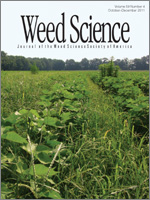Field studies were conducted in Knoxville, TN, over a 2-yr period (2007 and 2008) to determine the field dissipation rate and efficacy of pyroxasulfone, acetochlor, dimethenamid, and s-metolachlor to broadleaf signalgrass. Depending on rainfall patterns, pyroxasulfone at 209 g ai ha−1 provided broadleaf signalgrass control of > 75%, which was equal to or superior to acetochlor at 1,740 g ai ha−1, dimethenamid at 1,500 g ai ha−1 and s-metolachlor at 1,420 g ai ha−1. Pyroxasulfone provided residual control into the growing season and provides a tool for resistance management of later-emerging weeds. Herbicide dissipation was rapid in all soils (half-life usually < 20 d), although it was slower in a dry year. The order of herbicide dissipation and half-life in days in the 2 yr was acetochlor (3.5, 5 d) > dimethenamid (5, 9 d) > s-metolachlor (8.8, 27 d) > pyroxasulfone (8.2, > 71 d). There was poor correlation between observed weed control at 45 d after treatment and chemically determined herbicide concentrations at that same time, with ∼ 40% difference in 2007 and ∼ 50% difference in 2008.
Nomenclature: Acetochlor; dimethenamid; pyroxasulfone, s-metolachlor; broadleaf signalgrass, Urochloa platyphylla (Nash) R. D. Webster.





